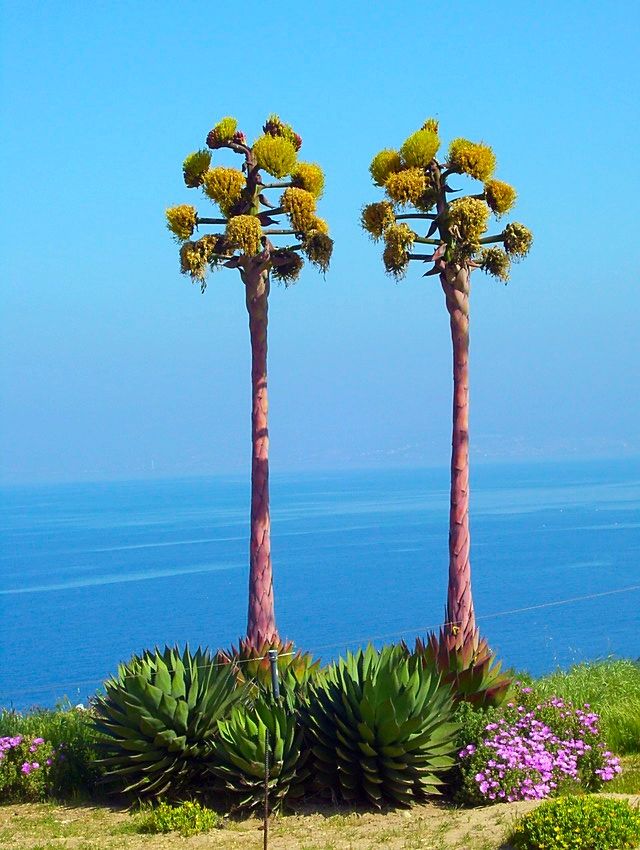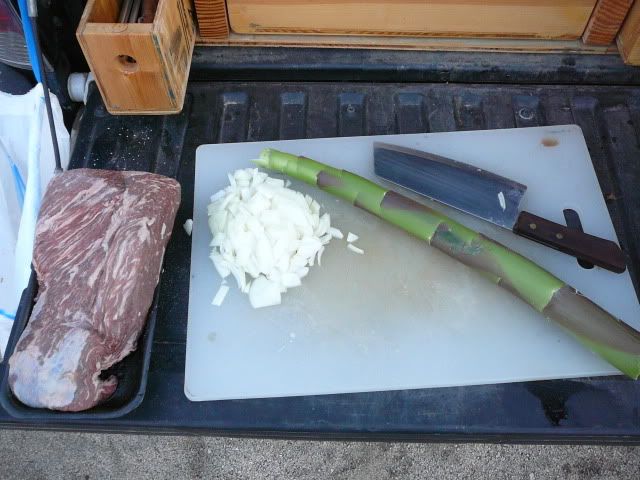They are incredibly beautiful cact OOPS !!! I mean AGAVE, for the botanically sensitive..)  , but man, what a pain they can be... we have tons (literally) in this area for landscaping, and when they do finally
bloom it's the end of the line for the plant. Those trunks are very dense, wet and heavy, and are designed by nature to fall over to spread their
offspring around; but when they do fall, fences or anything in their way is subject to a rude awakening. The carcass of the plant and its' stalk are
huge and difficult to discard; I'm talking chainsaw here. I had a neighbor who, to save our mutual fence, tied a rope to the stalk of his and pulled
it over with his pick-em-up truck; he learned the hard way to use a longer line next time; put quite a dent in the roof of his pride and joy. , but man, what a pain they can be... we have tons (literally) in this area for landscaping, and when they do finally
bloom it's the end of the line for the plant. Those trunks are very dense, wet and heavy, and are designed by nature to fall over to spread their
offspring around; but when they do fall, fences or anything in their way is subject to a rude awakening. The carcass of the plant and its' stalk are
huge and difficult to discard; I'm talking chainsaw here. I had a neighbor who, to save our mutual fence, tied a rope to the stalk of his and pulled
it over with his pick-em-up truck; he learned the hard way to use a longer line next time; put quite a dent in the roof of his pride and joy.
Love to see 'em....... in other people's yards. 
[Edited on 10-14-2015 by bajabuddha] |

 , never seen that before. I think the cactus know El Nino is coming to Baja
, never seen that before. I think the cactus know El Nino is coming to Baja
 , never seen that before. I think the cactus know El Nino is coming to Baja
, never seen that before. I think the cactus know El Nino is coming to Baja



 , but man, what a pain they can be... we have tons (literally) in this area for landscaping, and when they do finally
bloom it's the end of the line for the plant. Those trunks are very dense, wet and heavy, and are designed by nature to fall over to spread their
offspring around; but when they do fall, fences or anything in their way is subject to a rude awakening. The carcass of the plant and its' stalk are
huge and difficult to discard; I'm talking chainsaw here. I had a neighbor who, to save our mutual fence, tied a rope to the stalk of his and pulled
it over with his pick-em-up truck; he learned the hard way to use a longer line next time; put quite a dent in the roof of his pride and joy.
, but man, what a pain they can be... we have tons (literally) in this area for landscaping, and when they do finally
bloom it's the end of the line for the plant. Those trunks are very dense, wet and heavy, and are designed by nature to fall over to spread their
offspring around; but when they do fall, fences or anything in their way is subject to a rude awakening. The carcass of the plant and its' stalk are
huge and difficult to discard; I'm talking chainsaw here. I had a neighbor who, to save our mutual fence, tied a rope to the stalk of his and pulled
it over with his pick-em-up truck; he learned the hard way to use a longer line next time; put quite a dent in the roof of his pride and joy. 













